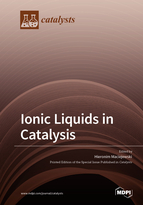Ionic Liquids in Catalysis
A special issue of Catalysts (ISSN 2073-4344).
Deadline for manuscript submissions: closed (31 January 2021) | Viewed by 39365
Special Issue Editor
Interests: catalysis by transition metal complexes; catalysis in ionic liquids; synthesis, technologies, and modification of inorganic polymers; synthesis and applications of hybrid materials; technologies of organosilicon compounds
Special Issue Information
Dear Colleagues,
Ionic liquids (ILs), due to their distinctive properties, have attracted the interest of researchers for over 30 years. This interest has mainly been focused on their use as a green alternative to volatile organic solvents. The application of ILs as solvents in chemical reactions is well-documented in the literature and constitutes one of the oldest directions of studies on ionic liquids. The unique properties of ILs, particularly their high polarity, non-volatility, and high thermal stability, enable us to perform high temperature and pressure processes. However, they often act not only as solvents but also as catalysts, catalyst immobilizers, and initiators. A number of excellent review papers as well as books are devoted to these applications, particularly to the role played by ILs in catalysis. Over 100 types of chemical reactions are known in which ILs were successfully applied. Among them are reactions catalyzed by transition metal complexes, including hydrogenation, oxidation, hydroformylation, carbonylation, metathesis, and coupling reactions. In most cases, ILs can dissolve and immobilize metal complexes and, at the same time, they are insoluble in reactants, thus enabling us to perform processes in biphasic systems and to easily isolate products (after a reaction) with the possibility of reusing the catalytic system. In recent years, we have observed an intensive development of supported ionic liquid phase (SILP) technology. In these materials, transition metal complexes can be immobilized within a thin layer of IL deposited on a solid support, such as silica, activated carbon, and various mesoporous materials. The SILP concept has great potential for transition-metal-catalyzed processes, such as hydroformylation and carbonylation, and fine chemical syntheses. However, in addition to the application of ionic liquids as immobilizing agents, more and more frequently attempts are being made to obtain metal-ion-containing ionic liquids with catalytic properties, namely halometallate ionic liquids, NHC complexes, etc.
This Special Issue aims to show the most recent advances and trends in the design, synthesis, and characterization of catalysts based on ILs, as well as presenting their activity, mechanistic aspects, and potential for application.
Prof. Dr. Hieronim Maciejewski
Guest Editor
Manuscript Submission Information
Manuscripts should be submitted online at www.mdpi.com by registering and logging in to this website. Once you are registered, click here to go to the submission form. Manuscripts can be submitted until the deadline. All submissions that pass pre-check are peer-reviewed. Accepted papers will be published continuously in the journal (as soon as accepted) and will be listed together on the special issue website. Research articles, review articles as well as short communications are invited. For planned papers, a title and short abstract (about 100 words) can be sent to the Editorial Office for announcement on this website.
Submitted manuscripts should not have been published previously, nor be under consideration for publication elsewhere (except conference proceedings papers). All manuscripts are thoroughly refereed through a single-blind peer-review process. A guide for authors and other relevant information for submission of manuscripts is available on the Instructions for Authors page. Catalysts is an international peer-reviewed open access monthly journal published by MDPI.
Please visit the Instructions for Authors page before submitting a manuscript. The Article Processing Charge (APC) for publication in this open access journal is 2700 CHF (Swiss Francs). Submitted papers should be well formatted and use good English. Authors may use MDPI's English editing service prior to publication or during author revisions.
Keywords
- immobilization of TM complexes
- supported ionic liquid phase
- NHC complexes
- halometallate ionic liquids
- transformations in ionic liquids
- stability of complexes in ionic liquids
- catalytic activity
- mechanistic aspects






